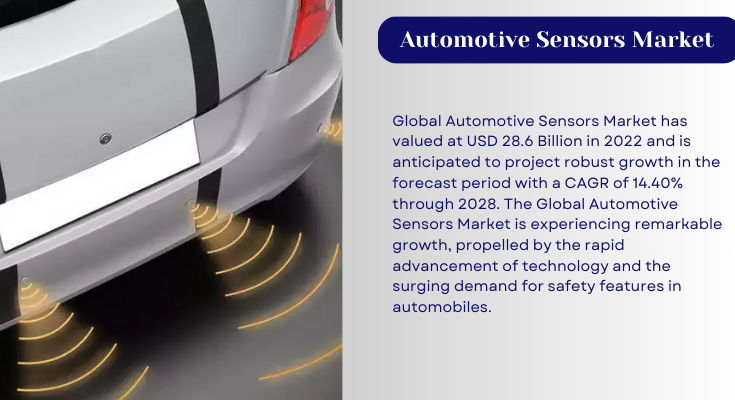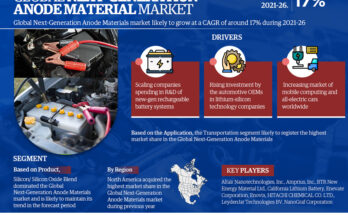According to TechSci Research report, “Global Automotive Sensors Market – Industry Size, Share, Trends, Competition Forecast & Opportunities, 2028”, the Global Automotive Sensors Market stood at USD 28.6 Billion in 2022 and is anticipated to grow with a CAGR of 14.40% in the forecast period, 2024-2028. The Global Automotive Sensors Market is experiencing remarkable growth, propelled by the rapid advancement of technology and the surging demand for safety features in automobiles. These sophisticated sensors play a crucial role in monitoring and managing a wide range of vehicle parameters, including engine performance, tire pressure, fuel efficiency, and environmental conditions. By enabling real-time data collection and analysis, these sensors not only enhance vehicle efficiency and driving experience but also contribute to the development of autonomous driving systems. With their ability to provide accurate and reliable information, automotive sensors are paving the way for safer and more intelligent vehicles of the future.
The market’s growth is being significantly fueled by the rapidly increasing adoption of autonomous and electric vehicles. These vehicles, which are at the forefront of technological innovation, heavily rely on a complex network of sensors for their safe and efficient operation. These sensors play a crucial role in enabling various functions such as collision avoidance, lane departure warning, adaptive cruise control, and even autonomous driving capabilities.
With the ever-growing demand for these advanced vehicles, the automotive sensor market is poised for substantial expansion in the coming years. As more and more consumers embrace the benefits of autonomous and electric vehicles, the need for reliable and high-performing sensors will continue to rise. This presents a tremendous opportunity for companies operating in the automotive sensor industry to develop cutting-edge technologies and meet the evolving demands of this rapidly evolving market.
In addition to rapid technological advancements and evolving vehicle trends, regulatory standards emphasizing vehicle safety and fuel efficiency have become crucial determinants propelling the automotive market forward. Governments worldwide are implementing stringent regulations and policies aimed at not only improving road safety but also reducing carbon emissions, thereby addressing the pressing concerns of climate change. As a result, there has been a widespread adoption of advanced sensor technologies in the automotive industry, enabling vehicles to become smarter and more responsive to the surrounding environment. This significant shift towards enhanced safety measures and eco-friendly practices has not only contributed to the market’s growth but has also laid the foundation for a sustainable future in the automotive industry.
However, despite the promising growth prospects, the automotive sensor market faces persistent challenges. One of the major obstacles is the high cost of sensors, which hinders their widespread adoption, particularly in developing markets where cost-effectiveness is crucial. Furthermore, as vehicles become increasingly connected and reliant on data, the issue of cybersecurity threats emerges as a significant concern. Manufacturers and industry stakeholders are diligently working on developing and implementing robust security measures to effectively mitigate these risks and ensure the safe and secure operation of vehicles in this rapidly evolving landscape. By addressing these challenges head-on, the automotive sensor market can pave the way for innovative solutions and drive further advancements in the industry.
Browse over market data Figures spread through 180 Pages and an in-depth TOC on the “Global Automotive Sensors Market” @ https://www.techsciresearch.com/report/automotive-sensors-market/20137.html
The Global Automotive Sensors Market is at the forefront of technological innovation, playing a pivotal role in shaping the future of the automotive industry. Sensors, once relegated to monitoring basic functions, have evolved into sophisticated components that enhance safety, efficiency, and overall driving experience. This transformative market is characterized by several key factors that underscore its significance and influence on the evolving automotive landscape.
The Global Automotive Sensors Market is experiencing substantial growth, driven by advancements in vehicle technologies and the increasing demand for safer, more connected, and autonomous vehicles. Automotive sensors are critical components that enable vehicles to perceive their surroundings, make real-time decisions, and enhance overall functionality. These sensors come in various types, including radar sensors, LiDAR, cameras, ultrasonic sensors, temperature sensors, and more, each serving a specific purpose in creating a comprehensive sensory network for vehicles.
Several factors contribute to the robust growth of the Global Automotive Sensors Market. The rise of Advanced Driver Assistance Systems (ADAS) is a significant driver, with consumers increasingly seeking vehicles equipped with features such as adaptive cruise control, lane departure warning, and automatic emergency braking. The demand for electric vehicles (EVs) is another driving force, necessitating advanced sensors for battery monitoring, thermal management, and overall performance optimization. The pursuit of autonomous driving capabilities further propels the need for cutting-edge sensors that enable vehicles to navigate, perceive obstacles, and make decisions autonomously.
Technological advancements are at the core of the Global Automotive Sensors Market’s evolution. LiDAR technology, in particular, is emerging as a game-changer, especially in the context of autonomous driving. LiDAR sensors, utilizing laser beams to create detailed 3D maps of the environment, provide a new level of precision in vehicle perception. This technology is instrumental in enhancing safety and decision-making capabilities, marking a paradigm shift in how vehicles interact with and interpret their surroundings.
Moreover, the integration of Artificial Intelligence (AI) and machine learning is transforming sensor capabilities. Sensors are no longer just data collectors; they are becoming intelligent systems that can adapt and learn from real-world experiences. AI-driven sensor systems enhance the accuracy of perception technologies such as image recognition, contributing to the development of more sophisticated ADAS and paving the way for enhanced autonomous driving capabilities.
The accelerating adoption of electric vehicles is reshaping the Automotive Sensors Market. Electric vehicles demand a unique set of sensors to monitor battery status, manage thermal conditions, and optimize energy consumption. As the electrification trend continues, sensor technologies that support the specific requirements of electric vehicles are gaining prominence. Sensors contribute not only to the efficient operation of electric powertrains but also to the development of regenerative braking systems, enhancing overall energy efficiency in electric vehicles.
Connectivity is a dominant trend influencing the Global Automotive Sensors Market. The integration of sensors facilitates Vehicle-to-Everything (V2X) communication, allowing vehicles to exchange information not only with each other (V2V) but also with infrastructure, pedestrians, and other road users. This level of communication, facilitated by a network of sensors and communication technologies, contributes to safer and more efficient traffic flow.
Sensors play a crucial role in V2X communication by collecting and transmitting data related to traffic conditions, road hazards, and the vehicle’s operational status. As the automotive industry moves towards connected and smart transportation systems, the trend is towards the development of sensors that support seamless and secure V2X communication. This includes sensors that can accurately detect and interpret signals from other vehicles, infrastructure, and the surrounding environment.
An emerging trend in the Global Automotive Sensors Market is the integration of sensors for health and wellness monitoring within vehicles. These sensors monitor the well-being of the driver and passengers, providing real-time data on vital signs, fatigue levels, and stress indicators. The goal is to enhance safety by detecting signs of driver impairment and alerting the driver or even triggering autonomous driving modes in certain situations.
Sensors for health and wellness monitoring are being integrated into steering wheels, seats, and other parts of the vehicle interior. The trend is towards creating a holistic in-car experience that not only focuses on driving performance but also prioritizes the well-being of occupants. As this trend evolves, the Automotive Sensors Market is likely to witness further innovations in biometric sensors and health monitoring technologies that contribute to a safer and more comfortable driving environment.
While the Global Automotive Sensors Market is experiencing significant growth, it is not without its challenges. Technological complexity and integration challenges pose hurdles, requiring continuous research and development efforts to create sensor systems that are reliable, scalable, and compatible with evolving vehicle architectures. Cost pressures and affordability concerns remain critical, necessitating a delicate balance between incorporating cutting-edge sensor technologies and keeping vehicles affordable for a broader consumer base.
Data security and privacy concerns are becoming increasingly prominent as vehicles become more connected. Ensuring the security of data transmitted and stored by automotive sensors is crucial to building and maintaining consumer trust in connected vehicles. Regulatory compliance and standardization challenges also persist as different regions may have varying regulatory frameworks, requiring sensor manufacturers to navigate a complex landscape of standards.
In conclusion, the Global Automotive Sensors Market is experiencing a transformative phase marked by technological advancements, electrification trends, connectivity, and innovative applications such as health monitoring. These trends collectively underscore the industry’s commitment to creating safer, more intelligent, and connected vehicles that align with the evolving expectations of consumers and the demands of a rapidly changing automotive landscape. As sensors become increasingly integral to the automotive ecosystem, their role in shaping the future of mobility is poised to expand further.
Major companies operating in the Global Automotive Sensors Market are:
- DENSO Corporation
- Infineon Technologies AG
- Robert Bosch GmbH
- Texas Instruments Inc.
- Sensata Technologies Holding PLC
- Aptiv PLC (Delphi Automotive)
- CTS Corporation
- Maxim Integrated Products Inc.
- NXP Semiconductors NV
- Analog Devices Inc.
Download Free Sample Report @ https://www.techsciresearch.com/sample-report.aspx?cid=20137
Customers can also request for 10% free customization on this report.
“The Global Automotive Sensors Market is a dynamic and pivotal sector, driving innovation in the automotive industry. Rapid technological advancements, including the integration of LiDAR, Artificial Intelligence, and health monitoring sensors, are reshaping vehicle capabilities. With a focus on enhancing safety, efficiency, and connectivity, automotive sensors play a crucial role in the rise of electric vehicles, the evolution of autonomous driving, and the establishment of Vehicle-to-Everything (V2X) communication. As vehicles become more intelligent and interconnected, the Automotive Sensors Market continues to be a catalyst for transformative changes, promising a future where vehicles are not just modes of transportation but intelligent, adaptive, and secure mobile platforms.” said Mr. Karan Chechi, Research Director with TechSci Research, a research-based management consulting firm.
“Automotive Sensors Market – Global Industry Size, Share, Trends, Opportunity, and Forecast, Segmented By Type (Temperature Sensors, Pressure Sensors, Speed Sensors, Level/Position Sensors, Magnetic Sensors, Gas Sensors, and Inertial Sensors), By Application (Powertrain, Body Electronics, Vehicle Security Systems, and Telematics), By Vehicle Type (Passenger Cars and Commercial Vehicles), By Region, Competition, 2018-2028”, has evaluated the future growth potential of Global Automotive Sensors Market and provides statistics & information on market size, structure and future market growth. The report intends to provide cutting-edge market intelligence and help decision makers take sound investment decisions. Besides, the report also identifies and analyzes the emerging trends along with essential drivers, challenges, and opportunities in the Global Automotive Sensors Market.
You may also read:
Hopper Car Market Insights- Strategies for Success in a Competitive Landscape [2028]
Automotive Wheel Speed Sensor Market Report- Understanding Market Size, Share, and Growth Factors [2028]
Autonomous Vehicle ECU Market Trends- Navigating the Path to Sustainable and Effective Solutions
Metal Foam Market – Unveiling Growth Trends & Analysis [2028]
Oil and Gas Valves Market Insights- Strategies for Success in a Competitive Landscape
Table of Content-Automotive Sensors Market
- Introduction
1.1. Product Overview
1.2. Key Highlights of the Report
1.3. Market Coverage
1.4. Market Segments Covered
1.5. Research Tenure Considered
- Research Methodology
2.1. Objective of the Study
2.2. Baseline Methodology
2.3. Key Industry Partners
2.4. Major Association and Secondary Sources
2.5. Forecasting Methodology
2.6. Data Triangulation & Validation
2.7. Assumptions and Limitations
- Executive Summary
3.1. Market Overview
3.2. Market Forecast
3.3. Key Regions
3.4. Key Segments
- Impact of COVID-19 on Global Automotive Sensors Market
- Global Automotive Sensors Market Outlook
5.1. Market Size & Forecast
5.1.1. By Value
5.2. Market Share & Forecast
5.2.1. By Type Market Share Analysis (Temperature Sensors, Pressure Sensors, Speed Sensors, Level/Position Sensors, Magnetic Sensors, Gas Sensors, and Inertial Sensors)
5.2.2. By Application Market Share Analysis (Powertrain, Body Electronics, Vehicle Security Systems, and Telematics)
5.2.3. By Vehicle Type Market Share Analysis (Passenger Cars and Commercial Vehicles)
5.2.4. By Regional Market Share Analysis
5.2.4.1. Asia-Pacific Market Share Analysis
5.2.4.2. Europe & CIS Market Share Analysis
5.2.4.3. North America Market Share Analysis
5.2.4.4. South America Market Share Analysis
5.2.4.5. Middle East & Africa Market Share Analysis
5.2.5. By Company Market Share Analysis (Top 5 Companies, Others – By Value, 2022)
5.3. Global Automotive Sensors Market Mapping & Opportunity Assessment
5.3.1. By Type Market Mapping & Opportunity Assessment
5.3.2. By Application Market Mapping & Opportunity Assessment
5.3.3. By Vehicle Type Market Mapping & Opportunity Assessment
5.3.4. By Regional Market Mapping & Opportunity Assessment
- Asia-Pacific Automotive Sensors Market Outlook
6.1. Market Size & Forecast
6.1.1. By Value
6.2. Market Share & Forecast
6.2.1. By Type Market Share Analysis
6.2.2. By Application Market Share Analysis
6.2.3. By Vehicle Type Market Share Analysis
6.2.4. By Country Market Share Analysis
6.2.4.1. China Market Share Analysis
6.2.4.2. India Market Share Analysis
6.2.4.3. Japan Market Share Analysis
6.2.4.4. Indonesia Market Share Analysis
6.2.4.5. Thailand Market Share Analysis
6.2.4.6. South Korea Market Share Analysis
6.2.4.7. Australia Market Share Analysis
6.2.4.8. Rest of Asia-Pacific Market Share Analysis
6.3. Asia-Pacific: Country Analysis
6.3.1. China Automotive Sensors Market Outlook
6.3.1.1. Market Size & Forecast
6.3.1.1.1. By Value
6.3.1.2. Market Share & Forecast
6.3.1.2.1. By Type Market Share Analysis
6.3.1.2.2. By Application Market Share Analysis
6.3.1.2.3. By Vehicle Type Market Share Analysis
6.3.2. India Automotive Sensors Market Outlook
6.3.2.1. Market Size & Forecast
6.3.2.1.1. By Value
6.3.2.2. Market Share & Forecast
6.3.2.2.1. By Type Market Share Analysis
6.3.2.2.2. By Application Market Share Analysis
6.3.2.2.3. By Vehicle Type Market Share Analysis
6.3.3. Japan Automotive Sensors Market Outlook
6.3.3.1. Market Size & Forecast
6.3.3.1.1. By Value
6.3.3.2. Market Share & Forecast
6.3.3.2.1. By Type Market Share Analysis
6.3.3.2.2. By Application Market Share Analysis
6.3.3.2.3. By Vehicle Type Market Share Analysis
6.3.4. Indonesia Automotive Sensors Market Outlook
6.3.4.1. Market Size & Forecast
6.3.4.1.1. By Value
6.3.4.2. Market Share & Forecast
6.3.4.2.1. By Type Market Share Analysis
6.3.4.2.2. By Application Market Share Analysis
6.3.4.2.3. By Vehicle Type Market Share Analysis



